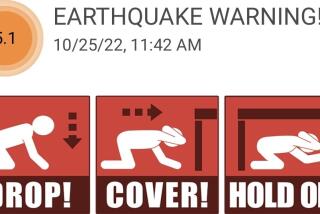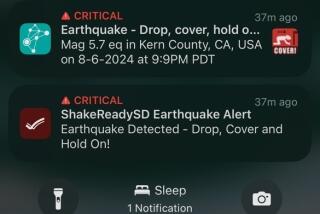Wait times drop for cellphone 911 calls in California
Millions of California cellphone users are no longer getting busy messages, experiencing unconnected calls or being put on hold for extended periods when they dial 911.
The number of wireless emergency calls reaching busy operators or failing to go through for various reasons dropped from 4.9 million or 42% of calls in 2007 to just 470,000 or 5% so far this year, according to the state’s Public Safety Communications Division. The improvement came even as cellphone 911 call volumes continued growing steadily.
In addition, the California Highway Patrol, by far the largest recipient of emergency cellphone calls, has significantly reduced the time that callers wait for someone to answer.
The new data represent a turnaround for a system that struggled for years to adapt as wireless devices rapidly proliferated, becoming the public’s primary link to police and fire rescuers.
When mobile phones were relatively rare, bulky contraptions installed chiefly in cars, all 911 wireless calls were sent to the CHP. By the late 1990s, as smaller, cheaper cellphones became ubiquitous, CHP call centers were being overwhelmed.
Callers often had to wait several minutes to reach an operator, only to then be quizzed and transferred to the nearest public safety dispatch center. The delays added crucial minutes to emergency response times.
The state reacted several years ago with a push to reroute many wireless calls, which now eclipse land-line emergency calls 2 to 1, directly to local police and fire agencies. State grants helped equip local dispatchers to handle their jurisdiction’s mobile calls.
Local dispatch centers now take 60% of wireless calls directly.
“We’ve really had some success in moving wireless calls” to public safety agencies best prepared to handle them, said Karen Wong, who heads the state division overseeing 911 programs.
Last year, about 17 million wireless 911 calls were made in the state, a 28% increase from 2007. Land-line emergency calls decreased 20% to 8.2 million over the same period.
Emergency call hold times at the CHP also have improved. In 2007, The Times reported that about half of the CHP’s call centers failed to meet state standards of 90% of 911 calls being answered in 10 seconds or less. Many were averaging delays of four times that or more, with some waits of 20 minutes or longer.
Over the last three months, all 25 of the centers exceeded the quick-answer standard, records show. Statewide this year, the agency has answered 94% or more of its emergency calls within 10 seconds.
A combination of increased staffing, more efficient operator scheduling and more refined call-routing procedures contributed to the improvement, said CHP Chief Reginald Chappelle, who oversees the 911 program.
“With these types of numbers, [callers] are going to hit some level of assurance that, no matter who they call, it will be answered in three rings or less,” he said.
The added burden of cell calls initially strained some local 911 call centers, including the city of Los Angeles. But generally, officials say they have adjusted and are serving the public better.
In 2008, Long Beach became one of the last large cities in the state to accept emergency cellphone calls directly. Officials were concerned about residents and visitors being routed through the CHP, but they feared that an influx of cell calls could swamp city dispatchers and delay emergency response times.
“The initial switch was a bit of a task,” said Lt. Ken Rosenthal, who supervises the city’s emergency call center. “But that’s long since gone. We’re doing fine.”
Getting calls directly is a significant benefit, he said. On a “medical rescue or a crime in progress,” he said, “obviously, seconds” can make a difference.
More to Read
Sign up for Essential California
The most important California stories and recommendations in your inbox every morning.
You may occasionally receive promotional content from the Los Angeles Times.










